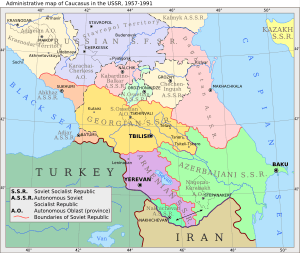Caucasus
The Caucasus (/ˈkɔːkəsəs/), or Caucasia[3][4] (/kɔːˈkeɪʒə/), is a region between the Black Sea and the Caspian Sea and mainly occupied by Armenia, Azerbaijan, Georgia, and south western Russia. It is home to the Caucasus Mountains, including the Greater Caucasus mountain range, which has historically been considered a natural barrier between Eastern Europe and Western Asia.[5]
| Caucasus | |
|---|---|
 Topography of the Caucasus | |
| Countries[1][2] | |
| Partially recognized countries | |
| Autonomous republics and federal regions |
|
| Demonym | Caucasian |
| Time Zones | UTC+02:00, UTC+03:00, UTC+03:30, UTC+04:00, UTC+04:30 |
| Highest mountain | Elbrus (5,642 m) |
Europe's highest mountain, Mount Elbrus, at 5,642 metres (18,510 ft) is in the west part of the Greater Caucasus mountain range.[6] On the southern side, the Lesser Caucasus includes the Javakheti Plateau and grows into the Armenian highlands, part of which is located in Turkey.[7]
The Caucasus region is separated into northern and southern parts – the North Caucasus (Ciscaucasus) and Transcaucasus (South Caucasus), respectively. The Greater Caucasus mountain range in the north is mostly shared by Russia and Georgia, as well as the northernmost parts of Azerbaijan. The Lesser Caucasus mountain range in the south is occupied by several independent states, namely, mostly by Armenia, Azerbaijan, and Georgia, but also extending to parts of northeastern Turkey, northern Iran and the partially recognised Artsakh Republic.
The region is known for its linguistic diversity: aside from Indo-European and Turkic languages, the Kartvelian, Northwest Caucasian, and Northeast Caucasian language families are indigenous to the area.
Origin of the name
The term Caucasus is derived from Caucas (Georgian: კავკასოსი Kawḳasosi) the son of the Biblical Togarmah and legendary forefather of Nakh peoples. According to Leonti Mroveli, the XI century Georgian chronicler, the word Caucasian is derived from the Vainakh ancestor Kavkas.[8] "The Vainakhs are the ancient natives of the Caucasus. It is noteworthy, that according to the genealogical table drawn up by Leonti Mroveli, the legendary forefather of the Vainakhs was "Kavkas", hence the name Kavkasians, one of the ethnicons met in the ancient Georgian written sources, signifying the ancestors of the Chechens and Ingush. As appears from the above, the Vainakhs, at least by name, are presented as the most "Caucasian" people of all the Caucasians (Caucasus - Kavkas - Kavkasians) in the Georgian historical tradition."[9][10]
Toponymy
The term Caucasus is not only used for the mountains themselves but also includes Ciscaucasia (which is part of the Russian Federation) and Transcaucasia.[11] According to Alexander Mikaberidze, Transcaucasia is a "Russo-centric" term.[12]
Pliny the Elder's Natural History (77–79 AD) derives the name of the Caucasus from Scythian kroy-khasis ("ice-shining, white with snow").[13] German linguist Paul Kretschmer notes that the Latvian word Kruvesis also means "ice".[14][15]
In the Tale of Past Years (1113 AD), it is stated that Old East Slavic Кавкасийскыѣ горы (Kavkasijskyě gory) came from Ancient Greek Καύκασος (Kaúkasos; later Greek pronunciation Káfkasos)),[16] which, according to M. A. Yuyukin, is a compound word that can be interpreted as the "Seagull's Mountain" (καύ-: καύαξ, καύηξ, ηκος ο, κήξ, κηϋξ "a kind of seagull" + the reconstructed *κάσος η "mountain" or "rock" richly attested both in place and personal names.)[17]
According to German philologists Otto Schrader and Alfons A. Nehring, the Ancient Greek word Καύκασος (Kaukasos) is connected to Gothic Hauhs ("high") as well as Lithuanian Kaũkas ("hillock") and Kaukarà ("hill, top").[16][18] British linguist Adrian Room points out that Kau- also means "mountain" in Pelasgian.[19]
The Transcaucasus region and Dagestan were the furthest points of Parthian and later Sasanian expansions, with areas to the north of the Greater Caucasus range practically impregnable. The mythological Mount Qaf, the world's highest mountain that ancient Iranian lore shrouded in mystery, was said to be situated in this region. The region is also one of the candidates for the location of Airyanem Vaejah, the apparent homeland of the Iranians of Zoroaster. In Middle Persian sources of the Sasanian era, the Caucasus range was referred to as Kaf Kof.[20] The term resurfaced in Iranian tradition later on in a variant form when Ferdowsi, in his Shahnameh, referred to the Caucasus mountains as Kōh-i Kāf.[20] "Most of the modern names of the Caucasus originate from the Greek Kaukasos (Lat., Caucasus) and the Middle Persian Kaf Kof".[20]
"The earliest etymon" of the name Caucasus comes from Kaz-kaz, the Hittite designation of the "inhabitants of the southern coast of the Black Sea".[20]
It was also noted that in Nakh Ков гас (Kov gas) means "gateway to steppe"[21]
Endonyms and exonyms
The modern name for the region is usually similar in many languages, and is generally between Kavkaz and Kawkaz.
- Abkhazian: Кавказ Kavkaz
- Adyghe: Къаукъаз/с Kʺaukʺaz/s
- Arabic: القوقاز al-Qawqāz
- Armenian: Կովկաս Kovkas
- Avar: Кавказ Kawkaz
- Azerbaijani: Qafqaz
- Chechen: Кавказ Kavkaz
- Georgian: კავკასია K'avk'asia
- German: Kaukasien
- Greek: Καύκασος Káfkasos
- Ingush: Кавказ Kawkaz
- Karachay-Balkar: Кавказ Kavkaz
- Kumyk: Къавкъаз Qawqaz
- Kurdish: Qefqasya/Qefqas
- Lak: Ккавкказ Kkawkkaz
- Lezgian: Къавкъаз K'awk'az
- Mingrelian: კავკაცია K'avk'acia
- Ossetian: Кавказ Kavkaz
- Persian: قفقاز Qafqāz
- Russian: Кавказ Kavkaz
- Rutul: Qawqaz Kavkaz
- Turkish: Kafkas/Kafkasya
- Ukrainian: Кавказ Kavkaz
Political geography
The North Caucasus region is known as the Ciscaucasus, whereas the South Caucasus region is commonly known as the Transcaucasus.
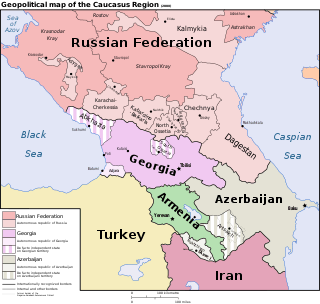
The Ciscaucasus contains most of the Greater Caucasus mountain range. It consists of Southern Russia, mainly the North Caucasian Federal District's autonomous republics, and the northernmost parts of Georgia and Azerbaijan. The Ciscaucasus lies between the Black Sea to its west, the Caspian Sea to its east, and borders the Southern Federal District to its north. The two Federal Districts are collectively referred to as "Southern Russia."
The Transcaucasus borders the Greater Caucasus range and Southern Russia to its north, the Black Sea and Turkey to its west, the Caspian Sea to its east, and Iran to its south. It contains the Lesser Caucasus mountain range and surrounding lowlands. All of Armenia, Azerbaijan (excluding the northernmost parts) and Georgia (excluding the northernmost parts) are in the South Caucasus.
The watershed along the Greater Caucasus range is generally perceived to be the dividing line between Europe and Southwest Asia. The highest peak in the Caucasus is Mount Elbrus (5,642 meters) located in western Ciscaucasus, and is considered as the highest point in Europe.
The Caucasus is one of the most linguistically and culturally diverse regions on Earth. The nation states that comprise the Caucasus today are the post-Soviet states Georgia (including Adjara and Abkhazia), Azerbaijan (including Nakhchivan), Armenia, and the Russian Federation. The Russian divisions include Dagestan, Chechnya, Ingushetia, North Ossetia–Alania, Kabardino–Balkaria, Karachay–Cherkessia, Adygea, Krasnodar Krai and Stavropol Krai, in clockwise order.
Three territories in the region claim independence but are recognized as such by only a handful of entities: Artsakh, Abkhazia and South Ossetia. Abkhazia and South Ossetia are recognized by the world community as part of Georgia, and Artsakh as part of Azerbaijan.
General statistics of South Caucasian states
| Armenia | Azerbaijan | Georgia | Total | |
|---|---|---|---|---|
| Coat of arms | 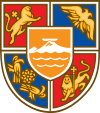 |
 |
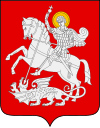 |
N/A |
| Flag | N/A | |||
| Capital | Yerevan | Baku | Tbilisi | N/A |
| Independence | N/A | |||
| Political system | Parliamentary republic | Semi-presidential republic | Parliamentary republic | N/A |
| Parliament | Azgayin Zhoghov | Milli Majlis | Parlamenti | N/A |
| Current President | Armen Sarkissian | Ilham Aliyev | Salome Zourabichvili | N/A |
| Population (2020) | ||||
| Area | 29,743 km2 = 11,484 sq mi | 86,600 km2 = 33,400 sq mi | 69,700 km2 = 26,900 sq mi | 186,043 km2 = 71,831 sq mi |
| Density | 101.5/km2 = 39.1/sq mi | 115/km2 = 44.4/sq mi | 53.5/km2 = 20.6/sq mi | 90/km2 = 34.7/sq mi |
| Water area % | 4.71% | 1.6% | 3.2% | |
| GDP (nominal) total (2019) | $13.444 billion | $47.171 billion | $15.925 billion | $76.540 billion |
| GDP (nominal) per capita (2019) | $4,528 | $4,689 | $4,289 | $4,571 |
| Military budget (2020) | $634 million | $2.267 billion | $290 million | $3.191 billion |
| Gini Index | 34.4 (2018) | 26.60 (2005) | 36.4 (2018) | N/A |
| HDI | 0.760 (High) | 0.754 (High) | 0.786 (High) | N/A |
| Internet TLD | .am | .az | .ge | N/A |
| Calling code | +374 | +994 | +995 | N/A |
Demographics
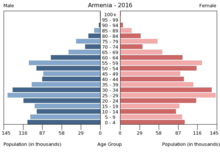
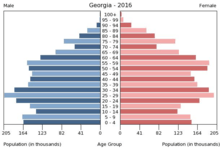

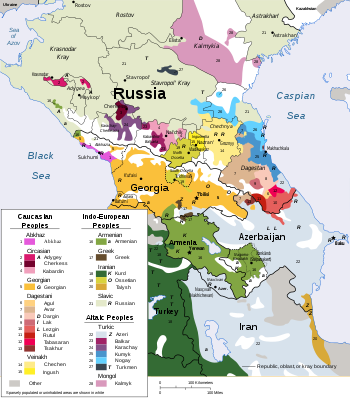
The region has many different languages and language families. There are more than 50 ethnic groups living in the region.[23] No fewer than three language families are unique to the area. In addition, Indo-European languages, such as East Slavic, Armenian and Ossetian, and Turkic languages, such as Azerbaijani, Kumyk language and Karachay–Balkar, are spoken in the area. Russian is used as a lingua franca most notably in the North Caucasus.
The peoples of the northern and southern Caucasus tend to be either Sunni Muslims, Eastern Orthodox Christians and Armenian Christians. Twelver Shi'ism has many adherents in the southeastern part of the region, in Azerbaijan which extends into Iran.
History
Located on the peripheries of Turkey, Iran, and Russia, the region has been an arena for political, military, religious, and cultural rivalries and expansionism for centuries. Throughout its history, the Caucasus was usually incorporated into the Iranian world.[24] At the beginning of the 19th century, the Russian Empire conquered the territory from Qajar Iran.[24]
Prehistory
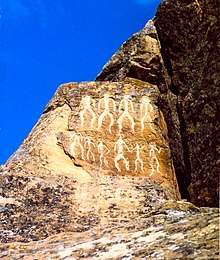
The territory of the Caucasus region was inhabited by Homo erectus since the Paleolithic Era. In 1991, early human (that is, hominin) fossils dating back 1.8 million years were found at the Dmanisi archaeological site in Georgia. Scientists now classify the assemblage of fossil skeletons as the subspecies Homo erectus georgicus.
The site yields the earliest unequivocal evidence for presence of early humans outside the African continent;[25] and the Dmanisi skulls are the five oldest hominins ever found outside Africa.
Antiquity
Kura–Araxes culture from about 4000 BC until about 2000 BC enveloped a vast area approximately 1,000 km by 500 km, and mostly encompassed, on modern-day territories, the Southern Caucasus (except western Georgia), northwestern Iran, the northeastern Caucasus, eastern Turkey, and as far as Syria.
Under Ashurbanipal (669–627 BC), the boundaries of the Assyrian Empire reached as far as the Caucasus Mountains. Later ancient kingdoms of the region included Armenia, Albania, Colchis and Iberia, among others. These kingdoms were later incorporated into various Iranian empires, including Media, the Achaemenid Empire, Parthia, and the Sassanid Empire, who would altogether rule the Caucasus for many hundreds of years. In 95–55 BC, under the reign of Armenian king Tigranes the Great, the Kingdom of Armenia included Kingdom of Armenia, vassals Iberia, Albania, Parthia, Atropatene, Mesopotamia, Cappadocia, Cilicia, Syria, Nabataean kingdom, and Judea. By the time of the first century BC, Zoroastrianism had become the dominant religion of the region; however, the region would go through two other religious transformations. Owing to the strong rivalry between Persia and Rome, and later Byzantium, the latter would invade the region several times, although it was never able to hold the region.
Middle Ages
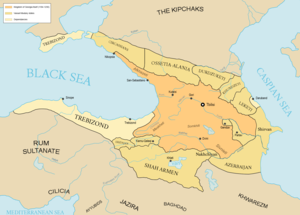
As the Arsacid dynasty of Armenia (an eponymous branch of the Arsacid dynasty of Parthia) was the first nation to adopt Christianity as state religion (in 301 AD), and Caucasian Albania and Georgia had become Christian entities, Christianity began to overtake Zoroastrianism and pagan beliefs. With the Muslim conquest of Persia, large parts of the region came under the rule of the Arabs, and Islam penetrated into the region.[26]
In the 10th century, the Alans (proto-Ossetians)[27] founded the Kingdom of Alania, that flourished in the Northern Caucasus, roughly in the location of latter-day Circassia and modern North Ossetia–Alania, until its destruction by the Mongol invasion in 1238–39.
During the Middle Ages Bagratid Armenia, Kingdom of Tashir-Dzoraget, Kingdom of Syunik and Principality of Khachen organized local Armenian population facing multiple threats after the fall of antique Kingdom of Armenia. Caucasian Albania maintained close ties with Armenia and the Church of Caucasian Albania shared same Christian dogmas with the Armenian Apostolic Church and had a tradition of their Catholicos being ordained through the Patriarch of Armenia.[28]
In the 12th century, the Georgian king David the Builder drove the Muslims out from Caucasus and made the Kingdom of Georgia a strong regional power. In 1194–1204 Georgian Queen Tamar's armies crushed new Seljuk Turkish invasions from the south-east and south and launched several successful campaigns into Seljuk Turkish-controlled Southern Armenia. The Georgian Kingdom continued military campaigns in the Caucasus region. As a result of her military campaigns and the temporary fall of the Byzantine Empire in 1204, Georgia became the strongest Christian state in the whole Near East area, encompassing most of the Caucasus stretching from Northern Iran and Northeastern Turkey to the North Caucasus.
The Caucasus region was conquered by the Ottomans, Mongols, local kingdoms and khanates, as well as, once again, Iran.
 Etchmiadzin Cathedral in Armenia, original building completed in 303 AD, a religious centre of Armenia. It is a UNESCO World Heritage Site.
Etchmiadzin Cathedral in Armenia, original building completed in 303 AD, a religious centre of Armenia. It is a UNESCO World Heritage Site.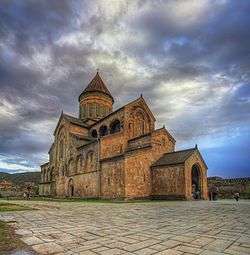 Svetitskhoveli Cathedral in Georgia, original building completed in the 4th century. It was a religious centre of monarchical Georgia. It is a UNESCO World Heritage Site.
Svetitskhoveli Cathedral in Georgia, original building completed in the 4th century. It was a religious centre of monarchical Georgia. It is a UNESCO World Heritage Site.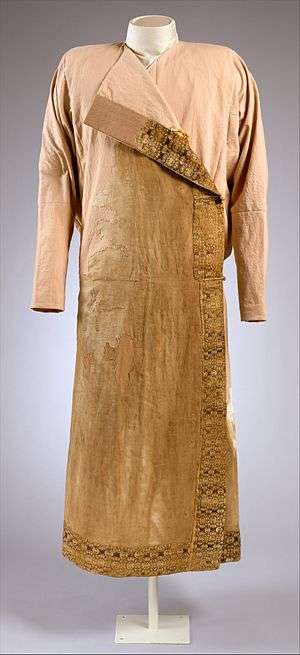 Northwest Caucasus caftan, 8-10th century, from the region of Alania.
Northwest Caucasus caftan, 8-10th century, from the region of Alania.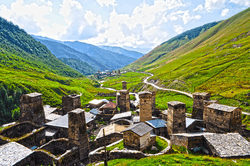 Svaneti defensive tower houses
Svaneti defensive tower houses Palace of the Shirvanshahs, 13-th-15th centuries
Palace of the Shirvanshahs, 13-th-15th centuries_2.jpg) Imamzadeh of Ganja, 7th-9th centuries
Imamzadeh of Ganja, 7th-9th centuries
Modern period
Up to and including the early 19th century, the Southern Caucasus and southern Dagestan all formed part of the Persian Empire. In 1813 and 1828 by the Treaty of Gulistan and the Treaty of Turkmenchay respectively, the Persians were forced to irrevocably cede the Southern Caucasus and Dagestan to Imperial Russia.[29] In the ensuing years after these gains, the Russians took the remaining part of the Southern Caucasus, comprising western Georgia, through several wars from the Ottoman Empire.[30][31]
In the second half of the 19th century, the Russian Empire also conquered the Northern Caucasus. In the aftermath of the Caucasian Wars, an ethnic cleansing of Circassians was performed by Russia in which the indigenous peoples of this region, mostly Circassians, were expelled from their homeland and forced to move primarily to the Ottoman Empire.[32][33]
In the 1940s, around 480,000 Chechens and Ingush, 120,000 Karachay–Balkars and Meskhetian Turks, thousands of Kalmyks, and 200,000 Kurds in Nakchivan and Caucasus Germans were deported en masse to Central Asia and Siberia. About a quarter of them died.[34]
The Southern Caucasus region was unified as a single political entity twice – during the Russian Civil War (Transcaucasian Democratic Federative Republic) from 9 April 1918 to 26 May 1918, and under the Soviet rule (Transcaucasian SFSR) from 12 March 1922 to 5 December 1936. Following the dissolution of the Soviet Union in 1991, Georgia, Azerbaijan and Armenia became independent nations.
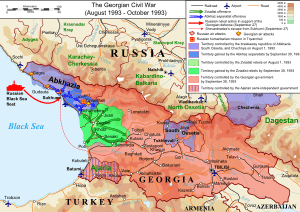
The region has been subject to various territorial disputes since the collapse of the Soviet Union, leading to the Nagorno-Karabakh War (1988–1994), the East Prigorodny Conflict (1989–1991), the War in Abkhazia (1992–93), the First Chechen War (1994–1996), the Second Chechen War (1999–2009), and the 2008 South Ossetia War.
Mythology
In Greek mythology, the Caucasus, or Kaukasos, was one of the pillars supporting the world. After presenting man with the gift of fire, Prometheus (or Amirani in the Georgian version) was chained there by Zeus, to have his liver eaten daily by an eagle as punishment for defying Zeus' wish to keep the "secret of fire" from humans.
In Persian mythology, the Caucasus might be associated with the mythic Mount Qaf which is believed to surround the known world. It is the battlefield of Saoshyant and the nest of the Simurgh.
The Roman poet Ovid placed the Caucasus in Scythia and depicted it as a cold and stony mountain which was the abode of personified hunger. The Greek hero Jason sailed to the west coast of the Caucasus in pursuit of the Golden Fleece, and there met Medea, a daughter of King Aeëtes of Colchis.
Folklore
The Caucasus has a rich folklore tradition.[35] This tradition has been preserved orally—necessitated by the fact that for most of the languages involved there was no alphabet until the early twentieth century—and only began to be written down in the late nineteenth century.[36] One important tradition is that of the Nart sagas, which tell stories of a race of ancient heroes called the Narts. These sagas include such figures as Satanaya, the mother of the Narts, Sosruquo a shape changer and trickster, Tlepsh a blacksmith god, and Batradz, a mighty hero.[35] The folklore of the Caucasus shows ancient Iranian Zoroastrian influence, involve battles with ancient Goths, Huns and Khazars, and contain many connections with ancient Indian, Norse Scandinavian, and Greek cultures.[37]
Links with Greek mythology
Caucasian folklore contains many links with the myths of the ancient Greeks. There are resemblances between the mother goddess Satanaya and the Greek goddess of love Aphrodite.[38] The story of how the trickster Nart Sosruquo, became invulnerable parallels that of the Greek hero Achilles.[39] The ancient Greek Amazons are connected with a Caucasian "warrior Forest-Mother, Amaz-an".[40]
Caucasian legends include stories involving giants similar to Homer's Polyphemus story.[41] In these stories, the giant is almost always a shepherd,[42] and he is variously a one-eyed rock-throwing cannibal, who lives in a cave (the exit of which is often blocked by a stone), kills the hero's companions, is blinded by a hot stake, and whose flock of animals is stolen by the hero and his men, all motifs which (along with still others) are also found in the Polyphemus story.[43] In one example from Georgia, two brothers, who are being held prisoner by a giant one-eyed shepherd called "One-eye", take a spit, heat it up, stab it into the giant's eye, and escape.[44]
There are also links with the ancient Greek myth of Prometheus.[45] Many legends, widespread in the Caucasus, contain motifs shared with the Prometheus story.[46] These motifs include: a giant hero, his conflict with God or gods, the stealing of fire and giving it to men, being chained, and being tormented by a bird who pecks at his liver (or heart).[47] The Adyge/Circassian Nart Nasran,[48] the Georgian Amirani,[49] the Chechen Pkharmat,[50] and the Abkhazian Abrskil,[51] are examples of such Prometheus-like figures.
Ecology
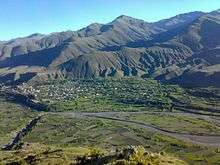
The Caucasus is an area of great ecological importance. The region is included in the list of 34 world biodiversity hotspots.[52][53] It harbors some 6400 species of higher plants, 1600 of which are endemic to the region.[54] Its wildlife includes Persian leopards, brown bears, wolves, bison, marals, golden eagles and hooded crows. Among invertebrates, some 1000 spider species are recorded in the Caucasus.[55][56] Most of arthropod biodiversity is concentrated on Great and Lesser Caucasus ranges.[56]
The region has a high level of endemism and a number of relict animals and plants, the fact reflecting presence of refugial forests, which survived the Ice Age in the Caucasus Mountains. The Caucasus forest refugium is the largest throughout the Western Asian (near Eastern) region.[57][58] The area has multiple representatives of disjunct relict groups of plants with the closest relatives in Eastern Asia, southern Europe, and even North America.[59][60][61] Over 70 species of forest snails of the region are endemic.[62] Some relict species of vertebrates are Caucasian parsley frog, Caucasian salamander, Robert's snow vole, and Caucasian grouse, and there are almost entirely endemic groups of animals such as lizards of genus Darevskia. In general, species composition of this refugium is quite distinct and differs from that of the other Western Eurasian refugia.[58]
The natural landscape is one of mixed forest, with substantial areas of rocky ground above the treeline. The Caucasus Mountains are also noted for a dog breed, the Caucasian Shepherd Dog (Rus. Kavkazskaya Ovcharka, Geo. Nagazi). Vincent Evans noted that minke whales have been recorded from the Black Sea.[63][64][65]
Energy and mineral resources
Caucasus has many economically important minerals and energy resources, such as alunite, gold, chromium, copper, iron ore, mercury, manganese, molybdenum, lead, tungsten, uranium, zinc, oil, natural gas, and coal (both hard and brown).
Tourism
Sport
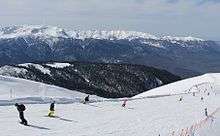
2014 Winter Olympics venue, Sochi, Russia. Krasnaya Polyana — a popular centre of mountain skiing and a snowboard venue. The 2015 European Games is the first in the history of the European Games to be held in Azerbaijan.
Mountain-skiing complexes:
- Alpika-Service
- Mountain roundabout
- Rosa Hutor
- Tsaghkadzor Ski Resort in Armenia
- Shahdag Winter Complex in Azerbaijan
The Azerbaijan Grand Prix (motor racing) venue was the first in the history of Formula One to be held in Azerbaijan The Rugby World Cup U20 (rugby) was in Georgia (country) 2017 In 2017 U-19 Europe Championship (Football) was held in Georgia.
See also
- Caucasian cuisine
- Community for Democracy and Rights of Nations
- Culture of Armenia
- Culture of Azerbaijan
- Culture of Georgia (country)
- Eastern Partnership
- Eurasian Economic Union
- Euronest Parliamentary Assembly
- Khanates of the Caucasus
- Parikaoba - traditional Caucasian fencing
- Prometheism
- Regions of Europe
- Transcontinental nations
References
- Wright, John; Schofield, Richard; Goldenberg, Suzanne (16 December 2003). Transcaucasian Boundaries. Routledge. p. 72. ISBN 9781135368500.
- "Caucasus | Mountains, Facts, & Map". Encyclopedia Britannica.
- Shamil Shetekauri et al., Mountain Flowers and Trees of Caucasia; Pelagic Publishing Limited, 2018, ISBN 178427173X.
- John L. Esposito, Abdulaziz Sachedina, The Islamic World: Past and Present 3-Volume Set; Oxford University Press, USA, 2004, ISBN 0195165209, p. 86.
- "Caucasus - region and mountains, Eurasia". Encyclopedia Britannica. Retrieved 26 November 2018.
- "CIA World Factbook – Russia, Geography". US CIA. US Central Intelligence Agency. Retrieved 22 February 2016.
- "Caucasus - region and mountains, Eurasia". Encyclopedia Britannica. Retrieved 26 November 2018.
West of the Kura-Aras Lowland rises the Lesser Caucasus range, which is extended southward by the Dzhavakhet Range and the Armenian Highland, the latter extending southwestward into Turkey.
- The work of Leonti Mroveli: "The history of the Georgian Kings" dealing with the history of Georgia and the Caucasus since ancient times to the 5th century AD, is included in medieval code of Georgian annals "Kartlis Tskhovreba".
- "Caucasian Knot | An Essay On the History of the Vainakh People. On the origin of the Vainakhs". Eng.kavkaz-uzel.ru. Archived from the original on 3 December 2013. Retrieved 3 November 2012.
- "Microsoft Word - 4C04B861-0826-0853BD.doc" (PDF). Archived from the original (PDF) on 25 February 2012. Retrieved 3 November 2012.
- "Caucasus - region and mountains, Eurasia". Encyclopedia Britannica. Retrieved 26 November 2018.
Caucasia includes not only the mountain ranges of the Caucasus proper but also the country immediately north and south of them. The land north of the Greater Caucasus is called Ciscaucasia (Predkavkazye, or “Hither Caucasia”) and that south of it is Transcaucasia (Zakavkazye, or “Farther Caucasia”).
- Mikaberidze, Alexander (6 February 2015). Historical Dictionary of Georgia. Rowman & Littlefield. ISBN 978-1-4422-4146-6.
- "Natural History," book six, chap. XVII
- Kretschmer, Paul (1928). "Weiteres zur Urgeschichte der Inder" [More about the Pre-History of the Indians]. Zeitschrift für vergleichende Sprachforschung auf dem Gebiete der indogermanischen Sprachen [Journal of Comparative Linguistic Research into Indo-European Philology] (in German). 55: 75–103.
- Kretschmer, Paul (1930). "Zeitschrift für vergleichende Sprachforschung auf dem Gebiete der indogermanischen Sprachen [Journal of Comparative Linguistic Research into Indo-European Philology]". 57: 251–255. Cite journal requires
|journal=(help) - Vasmer, Max Julius Friedrich (1953–1958). "Russisches etymologisches Wörterbuch" [Russian Etymological Dictionary]. Indogermanische Bibliothek herausgegeben von Hans Krahe. Reihe 2: Wörterbüche [Indo-European Library Edited by Hans Krahe. Series 2: Dictionaries] (in German). 1. Heidelberg: Carl Winter.
- Yuyukin, M. A. (18–20 June 2012). "О происхождении названия Кавказ" [On the Origin of the Name of the Caucasus]. Индоевропейское языкознание и классическая филология – XVI (материалы чтений, посвященных памяти профессора И. М. Тронского) (in Russian). Saint Petersburg. pp. 893–899 and 919. ISBN 978-5-02-038298-5. Retrieved 19 March 2017.
- Schrader, Otto (1901). Reallexikon der indogermanischen Altertumskunde: Grundzüge einer Kultur- und Völkergeschichte Alteuropas [Real Lexicon of the Indo-Germanic Antiquity Studies: Basic Principles of a Cultural and People's History of Ancient Europe] (in German). Strasbourg: Karl J. Trübner.
- Room, Adrian (1997). Placenames of the World: Origins and Meanings of the Names for over 5000 Natural Features, Countries, Capitals, Territories, Cities, and Historic Sites. Jefferson, NC: McFarland & Company. ISBN 978-0-7864-0172-7.
*kau-meaning.
- Gocheleishvili, Iago. "Caucasus, pre-900/1500". Encyclopaedia of Islam, THREE. Archived from the original on 12 June 2018. Retrieved 3 June 2018.
- Bolatojha J. "Древняя родина Кавкасов [The Ancient Homeland of the Caucasus]", p. 49, 2006.
- "ECMI – European Centre For Minority Issues Georgia". ecmicaucasus.org. Archived from the original on 4 September 2014. Retrieved 17 October 2014.
- "Caucasian peoples". Encyclopædia Britannica.
- Multiple Authors. "Caucasus and Iran". Encyclopædia Iranica. Retrieved 3 September 2012.
- Vekua, A., Lordkipanidze, D., Rightmire, G. P., Agusti, J., Ferring, R., Maisuradze, G., et al. (2002). A new skull of early Homo from Dmanisi, Georgia. Science, 297:85–9.
- Hunter, Shireen; et al. (2004). Islam in Russia: The Politics of Identity and Security. M.E. Sharpe. p. 3.
(..) It is difficult to establish exactly when Islam first appeared in Russia because the lands that Islam penetrated early in its expansion were not part of Russia at the time, but were later incorporated into the expanding Russian Empire. Islam reached the Caucasus region in the middle of the seventh century as part of the Arab conquest of the Iranian Sassanian Empire.
- "Яндекс.Словари". yandex.ru.
- "Caucasian Albanian Church celebrates its 1700th Anniversary". The Georgian Church for English Speakers. 9 August 2013. Retrieved 2 March 2018.
- Timothy C. Dowling Russia at War: From the Mongol Conquest to Afghanistan, Chechnya, and Beyond pp 728–730 ABC-CLIO, 2 dec. 2014. ISBN 978-1598849486
- Suny, page 64
- Allen F. Chew. "An Atlas of Russian History: Eleven Centuries of Changing Borders", Yale University Press, 1970, p. 74
- Yemelianova, Galina, Islam nationalism and state in the Muslim Caucasus. Caucasus Survey, April 2014. p. 3
- Memoirs of Miliutin, "the plan of action decided upon for 1860 was to cleanse [ochistit'] the mountain zone of its indigenous population", per Richmond, W. The Northwest Caucasus: Past, Present, and Future. Routledge. 2008.
- Weitz, Eric D. (2003). A century of genocide: utopias of race and nation. Princeton University Press. p. 82. ISBN 0-691-00913-9.
- Rashidvash, pp. 33–34.
- Mayor, p. xx; Hunt, p. 9.
- Rashidvash, pp. 33–34; for connections found in the Nart sagas, see Colarusso, pp. 5–7.
- Rashidvash, p. 33; Colarusso, pp. 6, 44, 53, 399.
- When Sosruquo was born burning in flames, the blacksmith god Tlepsh, grabbed Sosruquo and plunged him into water, making him invulnerable except where he was held by tongs, see Rashidvash, pp. 33–34; Colarusso, pp. 52–54 (Circassian Saga 8: Lady Setenaya and the Shepherd: The Birth of Sawseruquo), 185–186 (Abaza Saga 47: How Sosruquo Was Born), 387–394 (Ubykh Saga 86: The Birth of Soseruquo), cf. pp. 323–328 (Abkhaz Saga 75: The Mother of Heroes).
- Rashidvash, p. 34; Colarusso, pp. 130, 318.
- Hunt, pp. 9, 13, 201, 210–229; Bachvarova, p. 106; Mayor, pp. xxi; Rashidvash, p. 34; Colarusso. pp. 6–7, 170 (Circassian Saga 37: A Cyclops Bound atop Was'hamakhwa), 200–202 (Abaza Saga 52: How Sosruquo Brought Fire to His Troops).
- Hunt, p. 13.
- Hunt, Table 1, pp. 211–212.
- Hunt, pp. 218–222 (45. The Story of One-eye (Georgian)).
- Mayor, p. xxi; Hunt, pp. 14, 330–357; Calarusso, pp. 7, 170, 200—202; Rashidvash, p. 34.
- Hunt, p. 14. Hunt, p. 330, mentions forty-four versions.
- Hunt, pp. 330–331.
- Colarusso, pp. 158–168 (Circassian Saga 34: How Pataraz Freed Bearded Nasran, Who Was Chained to the High Mountain), 168–169 (Circassian Saga 35: Bound Nasran); Hunt, pp. 355–356; Rashidvash, p. 34.
- Hunt, pp. 332–337, 351–355; Colarusso, p. 169.
- Hunt, pp. 332, 339–344.
- Hunt, pp. 333, 347–351.
- Zazanashvili N, Sanadiradze G, Bukhnikashvili A, Kandaurov A, Tarkhnishvili D. 2004. Caucasus. In: Mittermaier RA, Gil PG, Hoffmann M, Pilgrim J, Brooks T, Mittermaier CG, Lamoreux J, da Fonseca GAB, eds. Hotspots revisited, Earth's biologically richest and most endangered terrestrial ecoregions. Sierra Madre: CEMEX/Agrupacion Sierra Madre, 148–153
- "WWF – The Caucasus: A biodiversity hotspot". panda.org. Archived from the original on 8 May 2013. Retrieved 2 August 2012.
- "Endemic Species of the Caucasus".
- "A faunistic database on the spiders of the Caucasus". Caucasian Spiders. Archived from the original on 28 March 2009. Retrieved 17 September 2010.
- Chaladze, G.; Otto, S.; Tramp, S. (2014). "A spider diversity model for the Caucasus Ecoregion". Journal of Insect Conservation. 18 (3): 407–416. doi:10.1007/s10841-014-9649-1. S2CID 16783553.
- van Zeist W, Bottema S. 1991. Late Quaternary vegetation of the Near East. Wiesbaden: Reichert.
- Tarkhnishvili, D.; Gavashelishvili, A.; Mumladze, L. (2012). "Palaeoclimatic models help to understand current distribution of Caucasian forest species". Biological Journal of the Linnean Society. 105: 231–248. doi:10.1111/j.1095-8312.2011.01788.x.
- Milne RI. 2004. "Phylogeny and biogeography of Rhododendron subsection Pontica, a group with a Tertiary relict distribution". Molecular Phylogenetics and Evolution 33: 389–401.
- Kikvidze Z, Ohsawa M. 1999. "Adjara, East Mediterranean refuge of Tertiary vegetation". In: Ohsawa M, Wildpret W, Arco MD, eds. Anaga Cloud Forest, a comparative study on evergreen broad-leaved forests and trees of the Canary Islands and Japan. Chiba: Chiba University Publications, 297–315.
- Denk T, Frotzler N, Davitashvili N. 2001. "Vegetational patterns and distribution of relict taxa in humid temperate forests and wetlands of Georgia Transcaucasia". Biological Journal of the Linnean Society 72: 287–332.
- Pokryszko B, Cameron R, Mumladze L, Tarkhnishvili D. 2011. "Forest snail faunas from Georgian Transcaucasia: patterns of diversity in a Pleistocene refugium". Biological Journal of the Linnean Society 102: 239–250
- "OceanCare - Protecting oceans and marine mammals".
- Horwood, Joseph (1989). Biology and Exploitation of the Minke Whale. p. 27.
- "Current knowledge of the cetacean fauna of the Greek Seas" (PDF). 2003: 219–232. Retrieved 21 April 2016. Cite journal requires
|journal=(help)
Sources
- Bachvarova, Mary R., From Hittite to Homer: The Anatolian Background of Ancient Greek Epic, Cambridge University Press, 2016. ISBN 978-0521509794.
- Coene, Frederick (2009). The Caucasus: An Introduction. Routledge. ISBN 978-0-415-48660-6.
- Colarusso, John, Nart Sagas from the Caucasus: Myths and Legends from the Circassians, Abazas, Abkhaz, and Ubykhs, Princeton University Press, 2002, 2014. ISBN 9781400865284.
- Cornell, Susan E., Small Nations and Great Powers: A Study of Ethnopolitical Conflict in the Caucasus.
- de Waal, Thomas (2010). The Caucasus: An Introduction. Oxford University Press. ISBN 978-0-19-539977-6.
- Golvin, Ivan, The Caucasus.
- Griffin, Nicholas, Caucasus: A Journey to the Land Between Christianity and Islam, University of Chicago Press, 2004. ISBN 9780226308593.
- Hunt, David, Legends of the Caucasus, Saqi Books, London, 2012. ISBN 978-0863568237.
- Mayor, Adrienne (2016), "Introduction to the Paperback Edition" in Nart Sagas: Ancient Myths and Legends of the Circassians and Abkhazians, by John Colarusso, Princeton University Press, 2016. ISBN 978-0691-16914-9.
- Suny, Ronald Grigor (1994). The Making of the Georgian Nation (2nd ed.). Indiana University Press. ISBN 0-253-20915-3.
Further reading
- Nikolai F. Dubrovin. The history of wars and Russian domination in the Caucasus (История войны и владычества русских на Кавказе). Sankt-Petersburg, 1871–1888, at Runivers.ru in DjVu and PDF formats.
- Gagarin, G. G. Costumes Caucasus (Костюмы Кавказа). Paris, 1840, at Runivers.ru in DjVu and PDF formats.
- Gasimov, Zaur: The Caucasus, European History Online, Mainz: Institute of European History, 2011, retrieved: 18 November 2011.
- Rostislav A. Fadeev. Sixty years of the Caucasian War (Шестьдесят лет Кавказской войны). Tiflis, 1860, at Runivers.ru in DjVu format.
- Kaziev Shapi. Caucasian highlanders (Повседневная жизнь горцев Северного Кавказа в XIX в.). Everyday life of the Caucasian Highlanders. The 19th Century (In the co-authorship with I. Karpeev). "Molodaya Gvardiy" publishers. Moscow, 2003. ISBN 5-235-02585-7
External links
| Wikimedia Commons has media related to Caucasus. |
| Wikivoyage has a travel guide for Caucasus. |
- Caucasian Journal — a multilingual online journal on South Caucasus
- Articles and Photography on Artsakh (Nagorno-Karabakh) from UK Photojournalist Russell Pollard
- Information for travellers and others about Caucasus and Georgia
- Caucasian Review of International Affairs—an academic journal on the South Caucasus
- BBC News: North Caucasus at a glance, 8 September 2005
- United Nations Environment Programme map: Landcover of the Caucasus
- United Nations Environment Programme map: Population density of the Caucasus
- Food Security in Caucasus (FAO)
- Caucasus and Iran entry in Encyclopædia Iranica
- University of Turin-Observatory on Caucasus
- Circassians Caucasus Web (Turkish)
- Georgian Biodiversity Database (checklists for ca. 11,000 plant and animal species)
